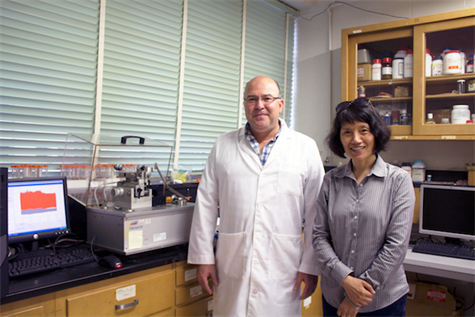According to the American Academy of Orthopedic Surgeons, two of every 100 Americans have an artificial joint where the ends of bones are removed or resurfaced and replaced with plastic, ceramic or metals. Titanium and ceramics such as alumina [aluminum oxide] and zirconia [zirconium oxide] account for most artificial joints.
 Dr. Hong Liang, professor in the Department of Mechanical Engineering and affiliated faculty in the Department of Materials Science and Engineering at Texas A&M University, along with her graduate student, M. Fezvi Ozaydin, have been studying a titanium-gold compound that is four times stronger than titanium and most steel alloys.
Dr. Hong Liang, professor in the Department of Mechanical Engineering and affiliated faculty in the Department of Materials Science and Engineering at Texas A&M University, along with her graduate student, M. Fezvi Ozaydin, have been studying a titanium-gold compound that is four times stronger than titanium and most steel alloys.
The compound made from a mixture of titanium and gold exhibits properties that are potentially useful for orthopedic, dental and prosthetic applications. The findings of the study published in Science Advances are part of the core research of Dr. Emilia Morosan, a physicist at Rice University.
Morosan combined three parts pure titanium with one part pure gold and melted them at scorching temperature, stumbling upon the compound by accident. She found that relatively high temperature produced an almost pure crystalline beta form of the compound. She attributed the strength to elevated valence electron density, reduced bond length and pseudo gap formation.
Liang and Ozaydin co-authored the study and are currently measuring the coefficient of friction, wear-rates and biocompatibility of the compound on a tribometer that simulates the movement of a human knee.
The applicability of the any material used in biomedical applications is determined by its biocompatibility and wear-rate in vivo. Depending on the use, the implants made from currently available materials last from 10 to 20 years. Artificial hip joints wear down faster than other joints due to pressure, weight and movement of the body. Over time, the friction causes implant particles to come lose, causing infection and inflammation of the surrounding tissue.
Liang is optimistic about the hardness and durability of the biocompatible compound. She expects to conduct more mechanical tests to further understand its properties. Despite the use of gold, Liang does not anticipate the price of the compound to rise dramatically.
“Titanium is the majority material used in the compound,” said Liang. “Besides, you’d be surprised how much people are willing to spend on a good artificial joint material.”
The original research publication can be found in the journal ScienceAdvances.